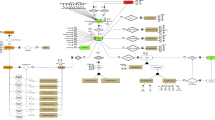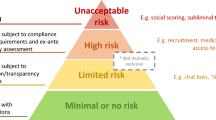Abstract
The study of critical infrastructure systems organization and behavior has drawn great attention in the recent years. This is in part due to their great influence on the ordinary life of every citizen. In this paper, we study critical infrastructures’ characteristics and propose a reference model based on the Unified Modeling Language (UML). This reference model attempts to provide suitable means for the task of modeling an infrastructure system through offering five major metamodels. We introduce each of these metamodels and explain how it is possible to integrate them into a unique representation to characterize various aspects of an infrastructure system. Based on the metamodels of UML-CI, infrastructure system knowledge bases can be built to aid the process of infrastructure system modeling, profiling, and management.












Similar content being viewed by others
References
Allenby, B. (2004). Infrastructure in the anthropocene: Example of information and communication technology. Journal of Infrastructure Systems, 10(3), 79–86.
Amin, M. (2000). National infrastructures as complex interactive networks. Automation, control and complexity: An integrated approach (pp. 263–286). New York: Wiley.
Atkinson, C., & Kuhne, T. (2003). Model-driven development: A metamodeling foundation. Software, IEEE, 20(5), 36–41.
Bagheri, E., & Ghorbani, A. A. (2006a). A service oriented approach to critical infrastructure modeling. In Workshop on service oriented techniques. National Research Council: Canada, August.
Bagheri, E., & Ghorbani, A. A. (2006b). Towards an mda-oriented uml profile for critical infrastructure modeling. In International conference on privacy, security and trust. ACM, October.
Bagheri, E., & Ghorbani, A. A. (2008a). Astrolabe: A collaborative multi-perspective goal-oriented risk analysis methodology. IEEE Transactions on Systems, Man and Cybernetics, Part A, in press.
Bagheri, E., & Ghorbani, A. A. (2008b) The state of the art in critical infrastructure protection: A framework for convergence. International Journal of Critical Infrastructures, 4(3), 215–244.
Bagheri, E., Baghi, H., Ghorbani, A. A., & Yari, A. (2007). An agent-based service-oriented simulation suite for critical infrastructure behavior analysis. International Journal of Business Process Integration and Management, 2(4), 312–326.
Barton, D. C., Eidson, E. D., Schoenwald, D. A., Stamber, K. L., & Reinert, R. K. (2000). Aspen-ee: An agent-based model of infrastructure interdependency. Technical Report SAND2000-2925.
Barton, D. C., & Stamber, K. L. (2000). An agent-based microsimulation of critical infrastructure systems. Technical Report SAND2000-0808C.
Basu, N., Pryor, R., & Quint, T. (1998). Aspen: A microsimulation model of the economy. Computational Economics, 12(3), 223–41.
Brown, T., Beyeler, W., & Barton, D. (2004). Assessing infrastructure interdependencies: the challenge of risk analysis for complex adaptive systems. International Journal of Critical Infrastructures, 1(1), 108–117.
CIP-Commission (1997). Critical foundations: Protecting Americas infrastructures. Technical report.
Dunn, M. (2005). The socio-political dimensions of critical information infrastructure protection (ciip). International Journal of Critical Infrastructures, 1, 258–268.
Fowler, M. (2004). Uml distilled: A brief guide to the standard object modeling language. New York: Addison-Wesley Professional.
Fuentes-Fernandez, L., & Vallecillo-Moreno, A. (2004). An introduction to uml profiles. UPGRADE, European Journal for the Informatics Professional, 5(2), 5–13, April.
Haimes, Y. Y. (1981). Hierarchical holographic modeling. Transaction on Systems, Man, and Cybernetics, 11, 606–617.
Haimes, Y. Y., Horowitz, B. M., Lambert, J. H., Santos, J. R., Lian, C., & Crowther, K. G. (2005a). Inoperability input-output model for interdependent infrastructure sectors. I: Theory and methodology. Journal of Infrastructure Systems, 11(2), 67–79.
Haimes, Y.Y., Horowitz, B.M., Lambert, J.H., Santos, J.R., Lian, C., & Crowther, K.G. (2005b). Inoperability input-output model for interdependent infrastructure sectors. II: Case studies. Journal of Infrastructure Systems, 11(2), 80–92.
Herder, P. M., Turk, A. L., Subrahmanian, E., & Westerberg, A. W. (2000). Challenges for process systems engineering in infrastructure design. Computers and Chemical Engineering, 24, 1775–1780. M3: doi:10.1016/S0098-1354(00)00463-4.
Jonsson, D. K. (2005). The nature of infrasystem services. Journal of Infrastructure Systems, 11(1), 2–8.
Kletz, T. A. (1999). Hazop and Hazan: Identifying and assessing process industry hazards. London: Taylor Francis.
Leontief, W. (1951). The structure of the American economy. New York: Oxford University Press.
Leontief, W. (1966). Input-output economics. New York: Oxford University Press.
Narich, R. (2005). Critical infrastructure, continuity of services and international cooperation. International Journal of Critical Infrastructures, 1, 293–298.
Nozick, L. K., Turnquist, M. A., Jones, D. A., Davis, J. R., & Lawton, C. R. (2005). Assessing the performance of interdependent infrastructures and optimising investments. International Journal of Critical Infrastructures, 1(2/3), 144–154.
Panzieri, S., Setola, R., & Ulivi, G. (2005). An approach to model complex interdependent infrastructures. In 16th IFAC World Congress.
Rinaldi, S. M. (2004). Modeling and simulating critical infrastructures and their interdependencies. In System sciences, 2004. Proceedings of the 37th annual Hawaii international conference on, p. 8.
Rinaldi, S. M., Peerenboom, J. P., & Kelly, T. K. (2001). Identifying, understanding, and analyzing critical infrastructure interdependencies. IEEE Control Systems Magazine, 21(6), 11–25.
Schoenwald, D. A., Barton, D. C., & Ehlen, M. A. (2004). An agent-based simulation laboratory for economics and infrastructure interdependency. In Proceedings of the 2004 American control conference (vol. 2, pp. 1295–1300).
Selic, B. (2003). The pragmatics of model-driven development. IEEE Software, 20(5), 19–25.
Thissen, W. A., & Herder, P. M. (2003). Critical infrastructures: challenges for systems engineering. In IEEE International conference on systems, man and cybernetics, 2003 (vol. 2, pp. 2042–2047).
Uml infrastructure specification, v2.1.1. Technical report, Object Management Group, February 2007.
Warmer, J., & Kleppe, A. (2003). The object constraint language: Getting your models ready for MDA. New York: Addison Wesley.
Author information
Authors and Affiliations
Corresponding author
Rights and permissions
About this article
Cite this article
Bagheri, E., Ghorbani, A.A. UML-CI: A reference model for profiling critical infrastructure systems. Inf Syst Front 12, 115–139 (2010). https://doi.org/10.1007/s10796-008-9127-y
Published:
Issue Date:
DOI: https://doi.org/10.1007/s10796-008-9127-y




